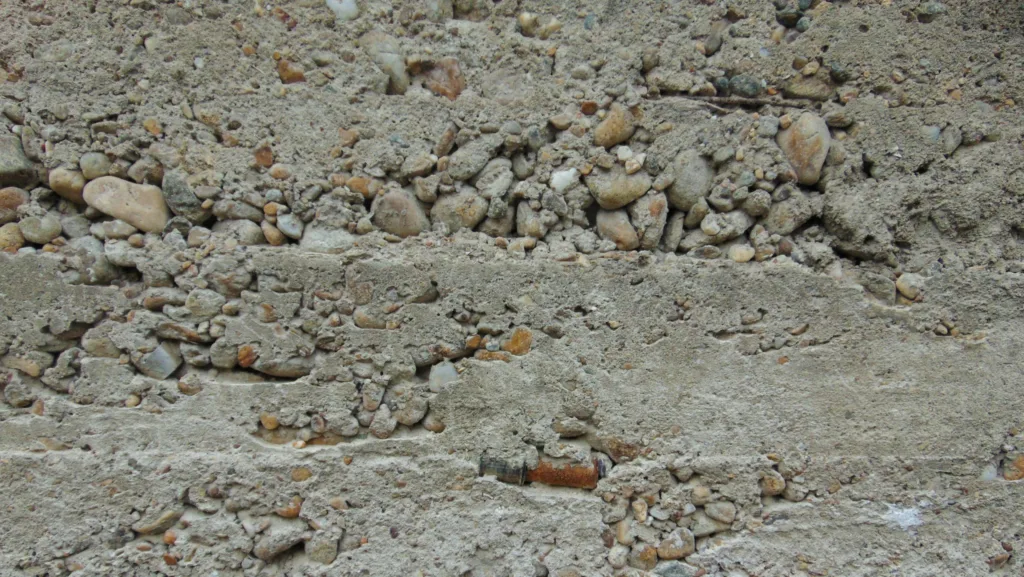Segregation in concrete refers to the separation of coarse aggregates from the cement paste during the mixing and placing process. This can occur due to improper mix design, excessive water content, or poor handling. It leads to uneven distribution of materials, impacting the concrete’s strength and durability.
Concrete segregation can occur due to several factors:
- Incorrect proportions of cement, aggregates, water, and additives can lead to an unbalanced mix, causing components to separate.
- Insufficient or excessive mixing time, as well as improper mixing techniques, can result in incomplete blending of materials and segregation.
- Too much water in the mix increases fluidity but also promotes segregation as it tends to separate the aggregates from the cement paste.
- Poorly graded aggregates: can lead to poor cohesion and increase the likelihood of separation during handling and placement.
- During transportation and pouring, allowing concrete to free-fall from a significant height can cause the heavier aggregates to settle at the bottom, leading to segregation.
- Inadequate or excessive vibration during concrete placement can affect the distribution of aggregates, contributing to segregation.
- Prolonged transportation of concrete over large distances can cause separation of materials, especially if the mix is not designed for such conditions.
Signs of segregation in concrete
- Separation of coarse and fine aggregates
- Presence of voids or pockets in the hardened concrete
- Clustering of coarse aggregates
- Variations in the texture and appearance of the concrete surface
- Difficulty in placing and finishing the concrete
- Uneven water movement to the surface during placement
Types of segregation in concrete
Aggregates Separation Segregation:
This type of segregation occurs when the weightier aggregates in the concrete settle and disengage from the cement and water amalgamation, causing an uneven mixture. The phenomenon is particularly prone to transpiring during transportation or the pouring phase. Aggregates, being denser, have a tendency to settle, resulting in a non-uniform distribution throughout the concrete. This separation can compromise the structural integrity, leading to issues like void formation and diminished concrete strength.

Cement Slurry Separation Segregation:
This type of segregation arises from an irregular distribution of the mixture, causing the water and cement to separate. Inappropriate mixers, insufficient mixing time, or an improper water-cement ratio are common culprits. The consequence is an inconsistent distribution of the cement slurry within the concrete mix. This imbalance can be detrimental, as it jeopardizes the homogeneity of the mixture, potentially giving rise to weakened concrete and structural vulnerabilities.

Bleeding Segregation:
This type of segregation occurs when water from the concrete mixture rises to the surface, leaving behind cement particles and aggregates. Excessive water content, insufficient fines in the mix, or prolonged vibration are contributing factors. This migration of water can result in surface defects and the formation of a weaker layer in the concrete structure. Proper attention to factors influencing bleeding is vital during the mixing and placement of concrete to prevent these undesirable effects.

Laitance Segregation:
Laitance, a delicate layer of fine particles that forms on the concrete surface due to overworking or excess water in the mix, can lead to segregation. If not effectively removed or compacted, this thin layer can segregate from the rest of the concrete, adversely impacting the bond between layers. The consequence is a compromised structural integrity, leading to reduced strength and durability of the overall structure.

Effects of segregation in concrete
Concrete segregation poses various detrimental effects on both the structural strength and aesthetic of concrete buildings and structures.
- Makes concrete more prone to water ingress, corrosion of reinforcement, and carbonation.
- Leads to the formation of cracks in the concrete, reducing its durability and overall lifespan.
- Uneven water distribution affects water-cement ratio, reducing durability.
- Leads to a weak and porous top surface.
- Creates voids, reducing concrete density and structural performance.
- Variations in colour and texture due to uneven distribution.
- Impacts handling, placement, compaction, and finishing.
- Influences inconsistent hardening and potential strength variations.
How to avoid segregation in concrete?
- Ensure accurate and uniform proportions of aggregates, cement, water, and admixtures in the mix design.
- Choose well-graded aggregates with varied particle sizes to enhance interlocking and reduce the risk of segregation.
- Control the water-cement ratio according to the mix design to prevent excess water that can lead to segregation.
- Use proper placement techniques, avoiding excessive free fall during pouring, and using chutes or drop chutes to minimise velocity.
- Use adequate vibration during concrete placement to consolidate the mix, eliminate air voids, and ensure uniform distribution, reducing segregation risk.
- Limit overworking of the concrete after placement to maintain particle distribution and prevent segregation.
- Consider environmental factors like temperature and wind during concrete work, using precautions such as shade or windbreaks to minimise adverse effects.
- Handle concrete carefully during transportation and placement, utilising appropriate equipment and avoiding manual mixing to prevent segregation.
- Pour concrete carefully to prevent void formation, placing it in layers and compacting each layer adequately to maintain uniformity and minimise segregation risk.
Conclusion
The effective prevention of segregation in concrete is important for ensuring the longevity and structural integrity of concrete buildings and structures. By adhering to precise mix designs, incorporating well-graded aggregates, controlling water-cement ratios, and employing proper placement techniques, the risk of segregation can be significantly diminished. Careful handling during transportation and placement, coupled with strategic vibration for consolidation, further contributes to achieving a homogeneous and durable concrete structure. As the construction industry continues to prioritize these practices, it inches closer to consistently delivering robust and enduring concrete structures, thereby minimizing challenges associated with segregation.


